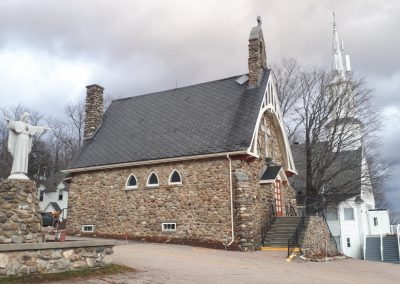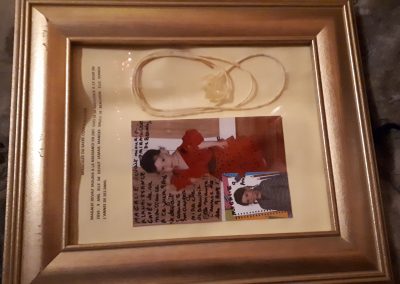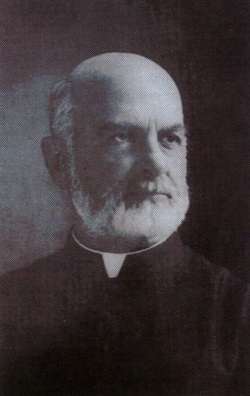Sacré-Coeur de Beauvoir shrine
Youth of Father Joseph-Arthur Laporte:
Father Joseph-Arthur Laporte was born in Saint-Paul de Joliette on August 15, 1857, the feast of the Assumption. He entered the community of the Clerics of Saint-Viateur on August 25, 1879. The members of this community have a great devotion to the Sacred Heart of Jesus, and it is through their contact that Father Laporte developed this devotion.
After his ordination on June 29, 1882 by Bishop Fabre, he ministered in the dioceses of Montreal and Joliette. He left the community of the Clerics of Saint-Viateur on July 28, 1886 and requested his incardination to the Bishop of Sherbrooke. He was admitted to the number of priests of the diocese by Bishop Antoine Racine, and appointed pastor of the parish of Sainte-Praxède de Bromptonville (1891-1902) from where he discovered the “mountain” that he would later call “Beauvoir”.
He was parish priest in Coaticook (1902-1903), and in 1903 he was promoted to head the large parish of Saint-Jean-Baptiste in Sherbrooke. He was the one who built the magnificent temple. He remained in this parish until his death on August 20, 1921.
Eight kilometers north of Sherbrooke, a small mountain of one hundred and fifteen meters, still unnamed, had long attracted the attention of this great lover of nature. After many approaches to Mr. Émile Lessard, a farmer, he bought two hectares of land from him in 1915. He gave the name “Beauvoir” (beautiful to see) to this corner of paradise whose panoramic view enchanted him. He decided to build a small cottage, a house of six meters on a side surrounded by a gallery. In 1916 and 1917, he bought more land to enlarge his small domain.
On May 28, 1919, Father Laporte signed a contract for a considerable expansion of his cottage. He would come every week to this refuge to rest from the noise and worries of city life. And in 1920, he founded the Sanctuary of the Sacred Heart of Beauvoir.
For years, Father Laporte has been fascinated by the devotion to the Sacred Heart of Jesus. He speaks of it tirelessly. So it is not surprising that the only decoration on the bare walls of his cottage is a lithograph, without much artistic pretension, of the Sacred Heart of Montmartre. (This frame is currently installed on the east wall of the small stone chapel). Before this eloquent sign of Love, he likes to sit peacefully and pray at length. “It is as if I were entering a sanctuary, I feel the presence of God and the need to pray… I speak to him without distraction as I would to a friend who would be there…”
In 1916, Father Laporte still dreamed of making Beauvoir a place where people would come to pray and celebrate the Sacred Heart of Jesus, whose devotion was spreading more and more throughout the country. He therefore decided to erect, not far from his cottage, a statue of the Sacred Heart. Measuring two meters in height, this statue, with its arms wide open, stands on a pedestal of field stones that farmers have faithfully transported on their carts.
The parish priest now invites his parishioners to come and taste the happiness that is his at the Sacred Heart… “Let us be attracted by the magnificent nature, prodigious in lines of all kinds, in colors, in perfumes… But let us be charmed much more by the author of this splendid decor: the God who creates out of love, and for love…”
The beginnings are slow. However, a few people came to pray, even during Father Laporte’s absences. The good priest always hoped “to attract more and more hearts to his Friend”. In 1917, he saw a “road” being built through the fields. It was more of a bumpy and muddy path that led to the statue of the Sacred Heart. At that time, this new road must have been quite a laborious work if one considers the accidents of the terrain!
As early as 1918, pilgrims began “the ascent of the Rosary”, a devotional practice that would have its heyday in the 1930s. On Sunday afternoons, pilgrims, starting from the main road, climbed to Beauvoir while reciting the rosary.
In 1933, at the request of the pilgrims, Father Pierre-Achille Bégin had a cross erected in front of the road leading to the Shrine. It is from this cross, still visible, that the pilgrimages to Beauvoir started. Along the way, wooden boards were set up on which were written the fifteen mysteries of the rosary. The pilgrims went up to Beauvoir accompanied by prayers and songs dedicated to Mary. For Beauvoir, the erection of this cross gives all its meaning to the ascent of the rosary: it is the beginning of the ascent, it is the cross of the rosary that the lips kiss before murmuring the “Aves”, the first links of this long chain that leads the pilgrims to the very Love that awaits them at the Shrine.
As we can see, in Beauvoir, just as Father Laporte desired, devotion to Mary was intimately linked to devotion to the Heart of Jesus. As early as 1916, Father Laporte wrote: “You will see that sooner or later there will be an altar up there from which the Sacred Heart will radiate its love.”
From 1918 to 1920, he would mature the next step he needed to take to correspond to the Love beckoning on the mountain. The idea of building a chapel in Beauvoir was becoming more and more important to him. But he had no money; he was almost destitute. Then, he felt his health was failing and he was out of breath… It was a difficult ordeal that the founder had to face.
In 1920, during a Holy Hour, he asked for a special favor from the Sacred Heart, with the promise of building a small chapel in Beauvoir if he was granted it. As he obtained the requested favor (the nature of which he never revealed), he had to admit defeat. With the help of some local craftsmen, he had the promised little chapel built.
To build a temple to the Sacred Heart, farmers from the surrounding area came through fields and paths, leading their horses that dragged loads of stones and wood. Farmers from Bromptonville, Stoke and Ascot will remember with pride having contributed to the construction of this small chapel.
Throughout the summer of 1920, workers, true lovers of the Sacred Heart, especially the Roy family (the father, Luc, and his seven children : Luc, Philippe, Édouard, Wilfrid, Adélard, Xavier and Georges), will work hard to build this chapel that generations of pilgrims will look upon as one of the places where the Heart of Jesus shows his love in a very special way. It will be a legitimate glory for them to say: “I used to come here often in the time of Father Laporte! “or “I worked to build the chapel! “.
It is an architectural jewel that Abbé Laporte had built on the hill of Beauvoir. He does not seem to realize it because he leaves in his notes: “Will it be pretty, this chapel? I don’t think so, but it will always be a chapel where I will celebrate mass. The stone is given to me and carted away. To save money, I have it laid as it is, without any cutting.
But the Sacred Heart, never defeated in generosity, knows how to reward his servant by giving to vile materials a stamp of rustic elegance, to a humble and poor building, a beauty that escapes no one. And all those who come to pray in this rustic chapel find there a calm, a peace that penetrates deep into their souls and leaves them pacified. One can almost feel the loving presence of the Sacred Heart of Jesus, which bends down with tenderness over those who come to visit it.
The exterior of this chapel is reminiscent in many ways of some of the country chapels of France. The rustic walls, the rudimentary furnishings and the few decorations are not likely to satisfy the connoisseur of expensive works of art. It is poverty, destitution. The only decoration is a statue, a frame, two statuettes, a few ex-votos testifying to the goodness of the Sacred Heart, lanterns and old images of the Way of the Cross. But, near the tabernacle, how one can taste with love and peace the divine presence of the Eucharistic Heart of Jesus!
On October 24, 1920, Bishop Larocque came to bless the little chapel. The next day, Father Laporte celebrated the first mass on Mount Beauvoir. He wrote in his diary: “I did my Sunday ministry here. Is this a dream or a reality? It is the realization of a beautiful dream. May I not sing my ‘Nunc dimittis servum tuum in pace’. “
Father Laporte senses his imminent death:
Father Laporte sensed that the Sacred Heart would come to take him to celebrate with him the eternal wedding of the Lamb. Father Laporte felt an immense joy in front of his crazy dream come true. However, his happiness was overshadowed by his poor health. “Will I be the instrument of the growth of this work…? I would like it without hoping for it. If not, God will have to put in the heart of the one who will succeed me the love that suddenly came to me for the idea of this sanctuary…”
In the spring of 1921, his health inexorably deteriorated. Even though he was ill, he was taken to Beauvoir four or five more times. Then he had to give up returning to Beauvoir. He was hospitalized at the Saint-Vincent-de-Paul Hospital at the beginning of August. From his hospital room, which he could no longer leave, the Abbot replayed in his mind the six brief years (1915-1921) when he had been able to give free rein to the passion of his life: the Sacred Heart of Jesus. And on August 20, Father Laporte was finally able to meet face to face with the one who was the great love of his life.
The body of Father Laporte now rests in the crypt of the church of Saint-Jean-Baptiste of which he was parish priest. However, on the west wall of the little chapel in Beauvoir, a commemorative plaque recalls the man who founded the Shrine and who continues to watch over its work from above.
Will Father Laporte’s work find a successor?
Father Laporte had bequeathed the Beauvoir property to the diocese on the condition that he pay the remaining $3,500 debt. The diocese refused this bequest. Beauvoir thus reverted to the universal legatee, Miss Euphémie Charest, Father Laporte’s former housekeeper. She sold Beauvoir in 1923 to the executor of Father Laporte’s will, the notary Gédéon Bégin, for the price of the debt. This wealthy businessman used Beauvoir Hill as a summer vacation spot for his family. Without knowing it, he was saving Beauvoir.
From 1923 to 1929, Beauvoir fell into almost complete abandonment. Only a few lovers of the Sacred Heart would go up there privately to pray at the foot of the Sacred Heart statue. But at the end of July 1929, Father Pierre Achille Bégin, a retired priest and brother of the owner, accompanied by a few members of the family, came to visit Beauvoir. Although the buildings had been quite damaged by thieves and the weeds had invaded the area, the group was charmed by the landscape and decided to settle there for two weeks.
From then on, the Bégin family would come to spend a few weeks in Beauvoir during the summer vacations. Father Bégin was told of the astonishing conversion of a young man in his twenties. Drawn in by a friend, he had come as a curious person, making fun of his friend’s superstition. At his friend’s insistence, and in order to have peace, he agreed to kneel before the statue of the Sacred Heart, feeling only the haste to leave… But he got up shaken. His heart and his mind are all changed. He found what he was not looking for, a sign of God’s love. His heart is overwhelmed with surprise. He finally found a great peace and an overflowing joy.
Without looking for signs, the good abbot knows how to recognize an invitation. First of all, together with his family members, he decided to restore the place and to revive the project of Father Laporte. Every year in June, he invites the people of the area for the triduum in preparation for the feast of the Sacred Heart. This is the highlight of the year.
Throughout the summer months, Father Bégin, surrounded by nephews and nieces, ensures for the pilgrims the mass every morning and the prayer at the Sacred Heart every evening as well as a Holy Hour every Thursday evening. Father Bégin, after Father Laporte, sought to spread devotion to the Sacred Heart. It is in the small stone chapel that he spends most of his time in prayer and in welcoming the small groups of pilgrims who continue to climb the mountain. “All my desire is that in Beauvoir the Sacred Heart be particularly honored, praised and prayed to, and that He spread His greatest graces there.”
Favors obtained even today:
Even today, the shrine of Beauvoir is frequented by many pilgrims. Many favors are still obtained there; most of them being rather spiritual favors, although some physical healings still take place on occasion. One of the most recent physical healings reported from the shrine is the healing of Magalie. She was to die at birth. Unable to feed herself, Magalie was force-fed from birth until she was nine years old. She was perfectly restored thanks to a miracle obtained at the Sacred Heart of Beauvoir.
Sources:
sanctuairedebeauvoir.qc.ca/histoire-du-sanctuaire/





